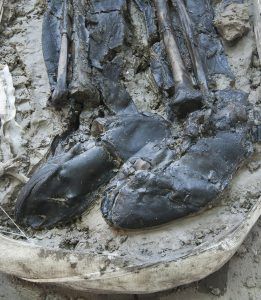Found Near the Thames: A Centuries-Old Skeleton, Still Wearing Thigh-High Boots
The owner of the unusual footwear likely made his living on the water
/https://tf-cmsv2-smithsonianmag-media.s3.amazonaws.com/filer/a9/40/a940c68e-c1e2-4dd2-9f74-758e49924728/the-booted-man-discovered-on-the-tideway-site-at-chambers-wharf-in-london-c-mola-headland-infrastructure-1-1024x668.jpg)
Archaeologists in London recently unearthed the centuries-old skeleton of an unidentified man while working at a site near the River Thames. It isn’t unusual to find traces of the city’s past inhabitants on the shores of its famed river; everything from Roman pottery to the skeleton of an 18th- or 19th-century child have been discovered there. And, thanks to the anaerobic nature of Thames’ mud, such treasures found in the oxygen-free space are exceptionally preserved. But several features of the man’s remains gave archaeologists pause.
For one, as Roff Smith reports for National Geographic, the skeleton was found face-down, with the man’s right arm flung over his head and his left arm bent back—an odd position suggesting that he had not been buried deliberately. Even more remarkable was the fact that a pair of thigh-high leather boots still clung to the bones of the skeleton’s decomposed feet.
This stunning discovery was made during archaeological work at a site along the Thames Tideway Tunnel, a planned sewage network that is due to be completed by 2023. According to MOLA Headland, a collaboration between the Museum of London Archaeology and Headland Archaeology to provide heritage services to infrastructure projects, the site sits at a river bend downstream from the Tower of London—“a natural confluence where materials accumulate in the river.”
The dead man’s boots were sturdy. They had been made of leather, fortified with extra soles, and stuffed with an as-of-yet unidentified material, perhaps to make them warmer or to improve their fit. The style of the boots leads experts to believe that the man lived in the late 15th or early 16th century, but his choice of footwear is not often attested to in archaeological or written records.
“[W]e never find high boots like this – they are always shoes or ankle boots,” Beth Richardson of MOLA Headland tells the Guardian’s Esther Addley. “High boots are just not very common throughout medieval times, and actually [during] Tudor times and the 17th century as well. If you look at pictures or illuminated manuscripts or portraits, very few people are wearing boots.”

Archaeologists consequently believe that the boots were waders, made to be worn while trekking through the waters and sticky mud of the Thames. This in turn suggests that the man made his living around the river, though the precise nature of his occupation is not known. He may have been a fisherman or a sailor, or even a treasure-hunting “mudlark”—a person who scavenges in rivers, looking for items of value.
Leather was an expensive material in centuries past, so it seems unlikely that the man’s boots would have been left in place had he been intentionally buried. Osteological experts have not found any signs that the man endured injuries at the time of demise, and they suspect his death was an accident. According to James Pickford of the Financial Times, the site where the skeleton was found is on land today, but was likely submerged in water at the time of the man’s death. Did he become trapped in tidal muck and drown? Did he fall into the river and die because he could not swim? At this point, it is impossible to say.
Though much about the man remains mysterious, analysis of his bones offers a tantalizing glimpse into his life. Experts think he could have been under 35 when he died, but his skeleton shows signs of advanced wear and tear—not to mention violence. Injuries to the man’s left hip suggest he walked with a limp, his nose had been broken at least once, and his forehead shows evidence of having sustained a blunt force injury that healed before he died. The man also had osteoarthritis, and the vertebrae of his back had started to fuse. He likely experienced chronic pain.
Damage to the man’s skeleton likely resulted from working a physically demanding job. Deep grooves across his teeth bolster the theory that he worked on the water; experts say the degradation may have been caused by passing a rope through his teeth while his hands were otherwise occupied, as a fisherman would have done.
Further analysis of the remains in the coming months may yield additional clues about the mysterious man. For now, archaeologists are glad to have even limited information about a long-forgotten London resident, who seems to have led a harsh existence before ending up in a watery grave. “It has been a privilege,” Richardson says, “to be able to study something so rare and so personal.”